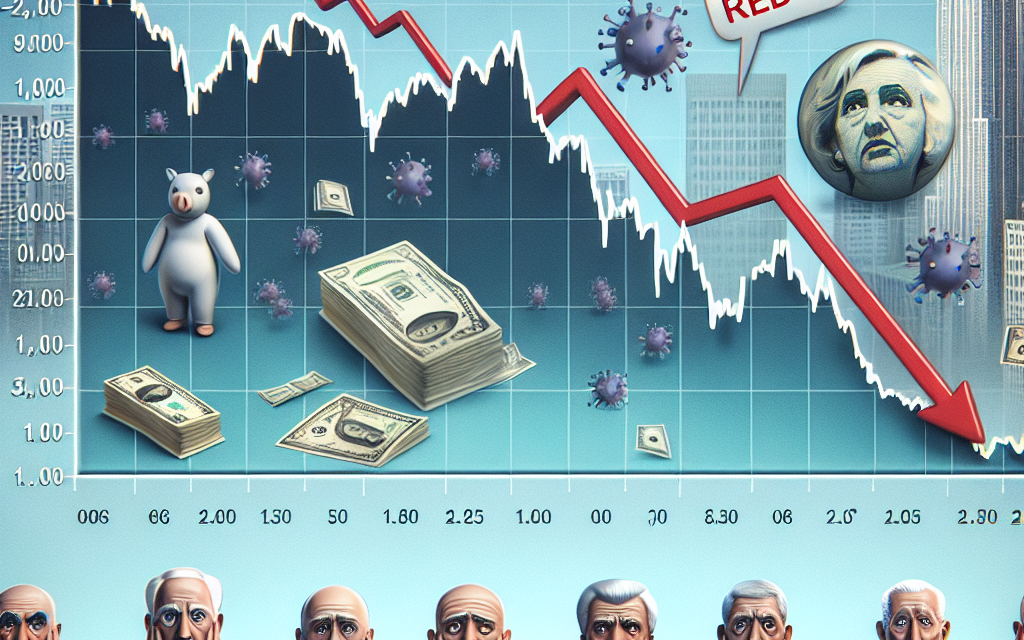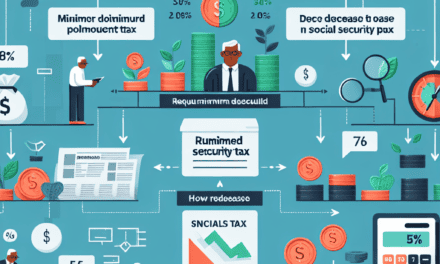“Market Retreat: S&P 500 and Nasdaq Dip as Investors Reassess Fed Rate Cut Expectations for 2025.”
Introduction
The S&P 500 and Nasdaq experienced notable declines as investors reassessed their expectations regarding potential Federal Reserve rate cuts in 2025. This shift in sentiment reflects growing concerns about inflation persistence and the central bank’s commitment to maintaining a tighter monetary policy. As market participants recalibrate their forecasts, the impact on technology and growth stocks, which are particularly sensitive to interest rate changes, has been pronounced, leading to increased volatility in these major indices. The market’s reaction underscores the delicate balance between economic growth prospects and the Fed’s monetary policy trajectory.
S&P 500 Performance Analysis Amid Fed Rate Cut Speculations
In recent weeks, the performance of the S&P 500 has been closely scrutinized as investors recalibrate their expectations regarding Federal Reserve interest rate cuts anticipated for 2025. The index, which serves as a barometer for the overall health of the U.S. stock market, has experienced notable fluctuations, reflecting the shifting sentiment among market participants. As speculation surrounding the Fed’s monetary policy evolves, the implications for the S&P 500 become increasingly significant.
Initially, the market had embraced a more optimistic outlook, buoyed by the prospect of potential rate cuts that could stimulate economic growth and enhance corporate profitability. However, as economic indicators began to suggest resilience in the U.S. economy, investors started to reassess the likelihood of such cuts occurring in the near future. This reassessment has led to a decline in the S&P 500, as market participants scale back their bets on a more accommodative monetary policy.
The recent economic data, including robust job growth and steady inflation rates, has contributed to a more hawkish stance among Fed officials. Consequently, the anticipation of rate cuts has diminished, leading to increased volatility in the stock market. Investors are now grappling with the reality that the Fed may maintain its current interest rate levels for a longer period than previously expected. This shift in sentiment has resulted in a reevaluation of stock valuations, particularly within sectors that are sensitive to interest rate changes.
Moreover, the technology sector, which has been a significant driver of the S&P 500’s performance in recent years, has also felt the impact of these changing expectations. As the Nasdaq composite index, heavily weighted with technology stocks, has experienced declines, the S&P 500 has followed suit. Investors are increasingly cautious about the growth prospects of tech companies, particularly in an environment where borrowing costs may remain elevated. This caution is reflected in the performance of high-growth stocks, which tend to be more sensitive to interest rate fluctuations.
In addition to sector-specific concerns, broader market dynamics are at play. The interplay between inflationary pressures and interest rate policies continues to shape investor sentiment. As inflation remains a persistent concern, the Fed’s approach to managing it will be critical in determining the trajectory of the S&P 500. If inflationary pressures persist, the Fed may be compelled to adopt a more aggressive stance, further dampening the prospects for rate cuts.
Furthermore, geopolitical factors and global economic conditions also contribute to the uncertainty surrounding the S&P 500. Trade tensions, supply chain disruptions, and international economic developments can all influence investor confidence and market performance. As such, the interconnectedness of global markets means that developments beyond U.S. borders can have a profound impact on domestic stock indices.
In conclusion, the S&P 500’s recent performance reflects a complex interplay of factors, including shifting expectations regarding Federal Reserve interest rate cuts, sector-specific dynamics, and broader economic conditions. As investors navigate this landscape, the focus will remain on economic indicators and Fed communications, which will ultimately guide market sentiment. The evolving narrative surrounding interest rates will continue to shape the outlook for the S&P 500, underscoring the importance of vigilance in an ever-changing market environment.
Nasdaq Trends: Investor Sentiment and Rate Cut Expectations
In recent weeks, the financial markets have experienced notable fluctuations, particularly within the S&P 500 and Nasdaq indices. These movements can largely be attributed to shifting investor sentiment regarding the Federal Reserve’s monetary policy, specifically the expectations surrounding potential interest rate cuts in 2025. As economic indicators continue to evolve, market participants are reassessing their positions, leading to a recalibration of their investment strategies.
The Nasdaq, which is heavily weighted towards technology stocks, has been particularly sensitive to changes in interest rate expectations. Investors in this sector often rely on future growth projections, which can be significantly impacted by the cost of borrowing. When the Fed signals a more hawkish stance, or when economic data suggests that inflation may persist longer than anticipated, the prospect of rate cuts diminishes. Consequently, this has led to a decline in tech stocks, as higher interest rates can erode profit margins and dampen growth prospects.
Moreover, the recent economic data releases have played a crucial role in shaping investor sentiment. For instance, stronger-than-expected employment figures and resilient consumer spending have raised concerns that the Federal Reserve may maintain its current rate levels for an extended period. As a result, investors have begun to scale back their bets on aggressive rate cuts, which had previously been a cornerstone of their investment thesis. This shift in expectations has not only affected the Nasdaq but has also reverberated throughout the broader market, contributing to declines in the S&P 500.
In addition to macroeconomic factors, geopolitical tensions and global economic uncertainties have further complicated the investment landscape. As investors grapple with the implications of these external factors, they are increasingly cautious about committing to high-growth sectors that are more vulnerable to interest rate fluctuations. This cautious approach has led to a more pronounced sell-off in technology stocks, which are often viewed as riskier investments in a rising rate environment.
Transitioning from the broader market dynamics, it is essential to consider the implications of these trends for individual investors. As the landscape evolves, market participants must remain vigilant and adaptable. The potential for continued volatility necessitates a thorough analysis of portfolio allocations, particularly for those heavily invested in growth-oriented sectors. Diversification may become a key strategy as investors seek to mitigate risks associated with interest rate changes and economic uncertainties.
Furthermore, the communication from the Federal Reserve will be critical in guiding investor sentiment moving forward. As the central bank navigates the complexities of inflation and economic growth, its messaging will likely influence market expectations and, consequently, stock performance. Investors will be closely monitoring upcoming Federal Open Market Committee meetings and economic reports to gauge the Fed’s trajectory and adjust their strategies accordingly.
In conclusion, the recent declines in the S&P 500 and Nasdaq reflect a broader reassessment of investor sentiment in light of changing expectations regarding Federal Reserve rate cuts. As economic indicators continue to evolve, market participants must remain agile, adapting their strategies to navigate the complexities of the current financial landscape. The interplay between interest rates, economic data, and investor sentiment will undoubtedly shape the trajectory of the markets in the months to come, underscoring the importance of informed decision-making in an ever-changing environment.
Impact of Federal Reserve Policies on S&P 500 and Nasdaq
The performance of major stock indices, such as the S&P 500 and Nasdaq, is often closely tied to the monetary policies enacted by the Federal Reserve. Recently, investors have begun to recalibrate their expectations regarding future interest rate cuts, particularly for the year 2025. This shift in sentiment has had a noticeable impact on the stock market, leading to declines in both the S&P 500 and Nasdaq. Understanding the interplay between Federal Reserve policies and market performance is crucial for grasping the current economic landscape.
As the Federal Reserve navigates the complexities of inflation and economic growth, its decisions regarding interest rates play a pivotal role in shaping investor behavior. When the Fed signals a potential easing of monetary policy, it typically encourages investors to increase their exposure to equities, anticipating that lower borrowing costs will stimulate economic activity and corporate profits. Conversely, when the outlook for rate cuts dims, as it has recently, investors often reassess their positions, leading to a pullback in stock prices.
The recent decline in the S&P 500 and Nasdaq can be attributed to a growing consensus among investors that the Fed may not be as aggressive in cutting rates as previously anticipated. This shift has been influenced by a series of economic indicators suggesting resilience in the labor market and persistent inflationary pressures. As a result, market participants are beginning to factor in a more cautious approach from the Fed, which has led to a reevaluation of growth prospects for technology and other sectors that are heavily represented in these indices.
Moreover, the technology sector, which is a significant driver of the Nasdaq’s performance, is particularly sensitive to interest rate changes. High-growth companies often rely on favorable borrowing conditions to finance expansion and innovation. When the prospect of lower interest rates diminishes, the valuation models for these companies can come under pressure, leading to a decline in stock prices. This dynamic was evident in the recent trading sessions, where major tech stocks experienced notable sell-offs, contributing to the overall downturn in the Nasdaq.
In addition to the immediate effects on stock prices, the Fed’s policy stance also influences investor sentiment and market psychology. As uncertainty regarding future rate cuts grows, investors may adopt a more defensive posture, reallocating their portfolios towards safer assets such as bonds or dividend-paying stocks. This shift can further exacerbate declines in growth-oriented indices like the S&P 500 and Nasdaq, as capital flows away from riskier assets.
Furthermore, the global economic environment plays a role in shaping the impact of Federal Reserve policies on U.S. markets. Geopolitical tensions, supply chain disruptions, and varying economic recovery rates across different regions can all influence investor confidence. As the Fed navigates these complexities, its decisions are scrutinized not only for their domestic implications but also for their potential ripple effects on global markets.
In conclusion, the recent declines in the S&P 500 and Nasdaq underscore the intricate relationship between Federal Reserve policies and stock market performance. As investors scale back their expectations for rate cuts in 2025, the resulting shifts in sentiment and capital allocation are likely to continue influencing market dynamics. Understanding these connections is essential for investors seeking to navigate the evolving economic landscape and make informed decisions in an increasingly complex financial environment.
Historical Context: Rate Cuts and Market Reactions
The relationship between Federal Reserve rate cuts and market reactions has been a focal point of economic analysis for decades. Historically, rate cuts are implemented by the Fed to stimulate economic growth during periods of stagnation or recession. When the central bank lowers interest rates, borrowing costs decrease, encouraging both consumer spending and business investment. This, in turn, often leads to a boost in corporate earnings, which can positively influence stock market performance. However, the timing and expectations surrounding these rate cuts can significantly impact investor sentiment and market dynamics.
In the past, when the Fed has signaled a potential easing of monetary policy, markets have typically responded with optimism. For instance, during the financial crisis of 2008, the Fed aggressively cut rates to near-zero levels, which helped to stabilize the economy and led to a substantial recovery in equity markets. Investors, anticipating a more favorable economic environment, often increased their exposure to stocks, driving indices like the S&P 500 and Nasdaq to new heights. This historical precedent illustrates how rate cuts can serve as a catalyst for market rallies, as they are perceived as a sign of support for economic growth.
However, the relationship is not always straightforward. In some instances, the mere speculation of rate cuts can lead to market volatility. For example, in 2019, when the Fed hinted at potential rate cuts amid trade tensions and slowing global growth, markets initially surged. Yet, as the reality of the economic situation unfolded, investor confidence fluctuated, leading to periods of both gains and losses. This illustrates that while rate cuts can provide a boost, they are often accompanied by uncertainty, which can lead to mixed reactions in the markets.
As we look at the current landscape, the recent decline in the S&P 500 and Nasdaq can be attributed to a recalibration of investor expectations regarding future Fed rate cuts. In 2025, many investors had anticipated a more accommodative monetary policy, which would have likely supported higher equity valuations. However, as economic indicators suggest resilience in growth and inflationary pressures persist, the Fed’s stance appears to be shifting. This has led to a reassessment of the likelihood and timing of rate cuts, prompting investors to scale back their bets on a more dovish monetary policy.
The implications of this shift are significant. When investors adjust their expectations regarding interest rates, it can lead to a revaluation of stocks, particularly those that are sensitive to interest rate changes, such as technology and growth-oriented companies. As the market digests this new information, volatility can increase, reflecting the uncertainty surrounding future economic conditions and monetary policy. Consequently, the recent pullback in major indices serves as a reminder of the delicate balance between interest rates and market performance.
In conclusion, the historical context of rate cuts and market reactions underscores the complexity of investor behavior in response to monetary policy changes. While rate cuts have historically been associated with positive market outcomes, the current environment illustrates that expectations can shift rapidly, leading to significant market adjustments. As investors navigate this evolving landscape, understanding the interplay between Fed actions and market sentiment will remain crucial for making informed investment decisions.
Sector Performance in the S&P 500 During Rate Cut Uncertainty
As the financial landscape continues to evolve, the performance of various sectors within the S&P 500 has become increasingly influenced by the prevailing uncertainty surrounding Federal Reserve rate cuts. Recently, investors have begun to recalibrate their expectations regarding potential rate reductions in 2025, leading to notable fluctuations in market dynamics. This shift in sentiment has had a pronounced impact on sector performance, as different industries respond uniquely to changes in monetary policy.
In the wake of this uncertainty, the technology sector, which has historically been sensitive to interest rate movements, has experienced a decline. As investors scale back their bets on imminent rate cuts, the appeal of high-growth tech stocks diminishes. This is primarily due to the fact that lower interest rates typically enhance the present value of future earnings, making tech companies, which often rely on future growth projections, more attractive. Conversely, as the prospect of rate cuts recedes, the valuation of these companies comes under pressure, leading to a sell-off in tech stocks. Consequently, major indices like the Nasdaq have reflected this trend, showcasing the sector’s vulnerability to shifts in monetary policy expectations.
Meanwhile, the financial sector has exhibited a contrasting response to the evolving interest rate narrative. Banks and financial institutions generally benefit from a higher interest rate environment, as it allows them to widen their profit margins on loans. As investors reassess the likelihood of rate cuts, financial stocks have shown resilience, with many institutions reporting robust earnings driven by increased lending activity. This divergence highlights the complex interplay between sector performance and interest rate expectations, as financials capitalize on the current environment while tech stocks grapple with the implications of a potentially prolonged period of higher rates.
In addition to technology and financials, the consumer discretionary sector has also felt the effects of shifting investor sentiment. Companies within this sector, which often rely on consumer spending fueled by favorable borrowing conditions, may face headwinds if rate cuts are delayed. As borrowing costs remain elevated, consumers may become more cautious in their spending habits, leading to a slowdown in sales for discretionary goods. This potential shift in consumer behavior underscores the interconnectedness of monetary policy and sector performance, as the consumer discretionary sector navigates the challenges posed by a less favorable interest rate environment.
On the other hand, the utilities sector has emerged as a relative safe haven during this period of uncertainty. Traditionally viewed as a defensive sector, utilities tend to perform well in times of market volatility, as they provide essential services that remain in demand regardless of economic conditions. As investors seek stability amidst the backdrop of fluctuating interest rate expectations, utilities have garnered increased interest, leading to a more favorable performance compared to more cyclical sectors.
In conclusion, the uncertainty surrounding Federal Reserve rate cuts in 2025 has created a complex landscape for sector performance within the S&P 500. While technology stocks have faced challenges due to recalibrated growth expectations, financials have capitalized on the current interest rate environment. Simultaneously, consumer discretionary companies are bracing for potential shifts in consumer spending, while utilities have emerged as a bastion of stability. As investors continue to navigate this evolving landscape, the interplay between monetary policy and sector performance will remain a critical focal point in the months ahead.
Investor Strategies: Navigating Market Volatility in 2025
As the financial landscape continues to evolve, investors are increasingly faced with the challenge of navigating market volatility, particularly in light of recent developments regarding the Federal Reserve’s monetary policy. The S&P 500 and Nasdaq have experienced notable declines as market participants reassess their expectations for interest rate cuts in 2025. This shift in sentiment underscores the importance of adopting strategic approaches to investment in an environment characterized by uncertainty and fluctuating economic indicators.
In the wake of these market movements, it is essential for investors to remain informed about the broader economic context. The Federal Reserve’s decisions regarding interest rates play a pivotal role in shaping market dynamics. As speculation surrounding potential rate cuts diminishes, investors must recalibrate their strategies to align with the evolving landscape. This recalibration may involve diversifying portfolios to mitigate risk, as reliance on a single asset class can expose investors to heightened volatility.
Moreover, understanding the implications of interest rate changes on various sectors is crucial. For instance, technology stocks, which have been a significant driver of growth in recent years, may react differently to shifts in interest rates compared to more traditional sectors such as utilities or consumer staples. As the Fed signals a more cautious approach to rate cuts, investors may want to consider reallocating their investments toward sectors that historically perform well in a rising interest rate environment. This strategic pivot can help cushion portfolios against potential downturns while capitalizing on opportunities that arise from changing economic conditions.
In addition to sector rotation, investors should also focus on the importance of maintaining a long-term perspective. Market volatility can often lead to emotional decision-making, which may result in hasty actions that undermine investment goals. By adhering to a disciplined investment strategy, individuals can better withstand short-term fluctuations and remain committed to their long-term objectives. This approach not only fosters resilience but also allows investors to take advantage of market corrections, potentially leading to favorable entry points for quality assets.
Furthermore, incorporating risk management techniques into investment strategies is paramount in times of uncertainty. Tools such as stop-loss orders and options can provide a safety net against significant losses, allowing investors to protect their capital while still participating in market upside. Additionally, regular portfolio reviews and adjustments can help ensure that investments remain aligned with individual risk tolerance and financial goals, particularly as market conditions evolve.
As investors navigate the complexities of the current market environment, staying informed about macroeconomic indicators and Federal Reserve communications is essential. Economic data releases, such as employment figures and inflation rates, can provide valuable insights into the trajectory of interest rates and overall market sentiment. By remaining vigilant and adaptable, investors can position themselves to respond effectively to changing conditions.
In conclusion, the recent decline in the S&P 500 and Nasdaq serves as a reminder of the inherent volatility present in financial markets. As expectations for Federal Reserve rate cuts in 2025 are reassessed, investors must adopt strategic approaches that encompass diversification, sector rotation, long-term perspectives, and robust risk management. By doing so, they can navigate the uncertainties of the market with greater confidence, ultimately enhancing their potential for long-term success in an ever-evolving economic landscape.
Future Outlook: S&P 500 and Nasdaq Predictions Amid Economic Changes
As the financial landscape continues to evolve, the S&P 500 and Nasdaq have recently experienced notable declines, reflecting a shift in investor sentiment regarding future Federal Reserve interest rate cuts. This adjustment in outlook is primarily driven by a series of economic indicators that suggest a more resilient economy than previously anticipated. Consequently, investors are recalibrating their expectations, leading to a more cautious approach in the equity markets.
In recent months, economic data has shown signs of strength, with robust job growth and consumer spending outpacing forecasts. This resilience has prompted speculation that the Federal Reserve may not be as aggressive in cutting interest rates in 2025 as some had initially expected. As a result, the prospect of prolonged higher interest rates has led to increased volatility in the stock markets, particularly affecting growth-oriented indices like the Nasdaq, which are more sensitive to changes in borrowing costs.
Moreover, the inflationary pressures that have persisted over the past year continue to play a significant role in shaping market dynamics. While inflation rates have shown signs of moderation, they remain above the Fed’s target, complicating the central bank’s decision-making process. Investors are now weighing the possibility that the Fed may adopt a more cautious stance, opting for a gradual approach to rate cuts rather than the aggressive easing that some had hoped for. This uncertainty has contributed to a more bearish sentiment in the markets, as participants reassess the implications of sustained higher rates on corporate earnings and economic growth.
In light of these developments, analysts are closely monitoring key economic indicators that could influence the Fed’s policy trajectory. For instance, upcoming reports on inflation, employment, and consumer confidence will be critical in shaping expectations for interest rates. Should these indicators suggest a continued economic expansion, it may reinforce the notion that the Fed will maintain a tighter monetary policy for an extended period. Conversely, any signs of economic weakness could reignite discussions around potential rate cuts, providing a glimmer of hope for investors seeking to capitalize on lower borrowing costs.
Furthermore, the geopolitical landscape and its impact on global markets cannot be overlooked. Ongoing tensions in various regions, coupled with supply chain disruptions, have the potential to influence economic stability and, by extension, the Fed’s policy decisions. Investors are increasingly aware that external factors can significantly affect domestic economic conditions, leading to a more cautious approach in their investment strategies.
As we look ahead, the future of the S&P 500 and Nasdaq will likely hinge on the interplay between economic data, Federal Reserve policy, and global events. While the current environment presents challenges, it also offers opportunities for discerning investors who can navigate the complexities of the market. The key will be to remain vigilant and adaptable, as the economic landscape continues to shift. Ultimately, the ability to anticipate changes in monetary policy and their implications for corporate earnings will be crucial in determining the trajectory of these major indices in the coming years. In conclusion, while the recent declines in the S&P 500 and Nasdaq reflect a recalibration of investor expectations, the future remains uncertain, underscoring the importance of a nuanced understanding of the economic factors at play.
Q&A
1. **Question:** What recent trend has been observed in the S&P 500 and Nasdaq indices?
**Answer:** Both the S&P 500 and Nasdaq have experienced declines as investors reduce their expectations for Federal Reserve rate cuts in 2025.
2. **Question:** Why are investors scaling back their bets on Fed rate cuts?
**Answer:** Investors are reassessing the likelihood of rate cuts due to stronger-than-expected economic data and inflation concerns.
3. **Question:** How do changes in Fed rate cut expectations typically affect stock markets?
**Answer:** Changes in rate cut expectations can lead to increased volatility in stock markets, often resulting in declines when cuts are deemed less likely.
4. **Question:** What impact does the Federal Reserve’s monetary policy have on technology stocks, particularly in the Nasdaq?
**Answer:** Higher interest rates can negatively impact technology stocks, as they often rely on borrowing for growth and are sensitive to changes in discount rates.
5. **Question:** What economic indicators are influencing investor sentiment regarding Fed rate cuts?
**Answer:** Key economic indicators such as employment data, inflation rates, and consumer spending are influencing investor sentiment.
6. **Question:** How might the Fed’s stance on interest rates affect future market performance?
**Answer:** If the Fed maintains higher interest rates for an extended period, it could lead to continued pressure on stock prices and slower economic growth.
7. **Question:** What should investors consider when evaluating the potential for future rate cuts?
**Answer:** Investors should consider economic trends, inflation data, and the Fed’s communication regarding its monetary policy outlook.
Conclusion
The recent decline in the S&P 500 and Nasdaq reflects investor caution as expectations for Federal Reserve rate cuts in 2025 diminish. This shift indicates a reassessment of economic conditions and monetary policy, leading to reduced risk appetite and a pullback in equity markets. As investors recalibrate their strategies in response to changing interest rate outlooks, the focus will likely remain on economic indicators and Fed communications moving forward.





